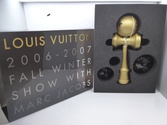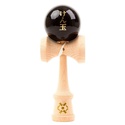And you thought the slinky kicked your butt as a kid.
Hang onto your seats because we’re going to take a trip over to Asia and discuss something fascinating and great and totally underrated: the Kendama.
{{ amazon }}
What is a Kendama?
The Kendama is a fun and mind-boggling hand game that looks really simple and easy but is actually deceptively hard. It looks simple enough: You try to get a ball, attached with a string, onto the handle of one of the cups or onto the point.
Why They Are Used
First off, there are over a thousand different techniques for players to accomplish the game. Yeah, and you thought Monopoly was hard. The Kendama can be played by any gender, at any age, and claims to help develop perseverance and concentration - but more recently, playing it has become a competitive sport. (We’ll use the term “sport” loosely here, since it seems like anything can be a sport nowadays.)
Most Expensive Kendama: The rare Mugen Kendamas are considered the rarest and consistently priced, coming in around the $200 or $300 per Kendama. Kendama lover and collector Sweets has one of the largest collections, and while all the prices are estimated, they are valued for around $1,000+ each. Louis Vuitton made a gold Kendama that you can purchase right now for 1,000,000 yen, or around $9,364 USD.
Of course, getting started in the game is a lot easier than buying a Louis Vutton branded toy. You can easily get a simple one for about $10 on Amazon.
Features of a Kendama:
-
Kozara: The left cup, the smallest size
-
Ozara: The right cup, the biggest one
-
Point: You should know what a point is
-
Ken: The main body stick
-
Chuzara: The bottom cup, the medium size
-
String: Attaches from the midpoint of the cups and point to the ball
-
Ball: Attached to string on one end and has a hole on the other to land atop the point
Origins
There seems to be quite a bit of debate surrounding where, exactly, the Kendama came from. There is a French version that seems to have origins as the predecessor to the current version: called the Bilboquet, it was played with a stick with two cups on either side, and the player would attempt to land the ball in the cups, then flip it over and try again.
Fun fact: the Kendama started out as a drinking game
Historical artifacts point to Greece or China as the inventors of the style and shape we’re more accustomed to today. However, the version that has become popularized in Japan today is believed to have arrived in Nagasaki during the Edo period, or sometime between 1603-1868.
Top 3 Basic Techniques to Play
First off, not only are there dozens upon dozens of ways to play, there is also a Japanese Kendama Association that will vote on and recognize specific techniques. So pick whichever tickles your fancy, or try one of these standard techniques.
Ozara, Chuzara, Kozara
-
Start with the ball hanging on its string below the stick
-
Quickly flip the ball into the air
-
Catch it in one of the cups
-
Repeat with each cup
-
Tip: Bend your knees & treat the ball like an egg (ie be gentle)
Tomeken
-
Start with the ball hanging down
-
Quickly flip it up
-
Attempt to catch the ball in such a way it’s hole lands on the point
-
Tip: Try not to laugh at the previous sentence, and also keep the ball’s hole facing down when you pull up
Hikoki
-
Hold the ball (what, not the stick? Yes. Just do it.)
-
Swing the stick out & away from you
-
Attempt to catch the point of the stick on the hole in the ball
-
Tip: Knees flexible, swing the stick in an arc motion
Master Level: Around Japan
-
Hold the stick in the point grip (underneath the big cup, point directed upwards)
-
Ball dangling below
-
Catch it on kozara, then toss and catch it on the ozara (or reverse order, whichever works for you)
-
Then perform the Tomeken, but from its placement in the cup








